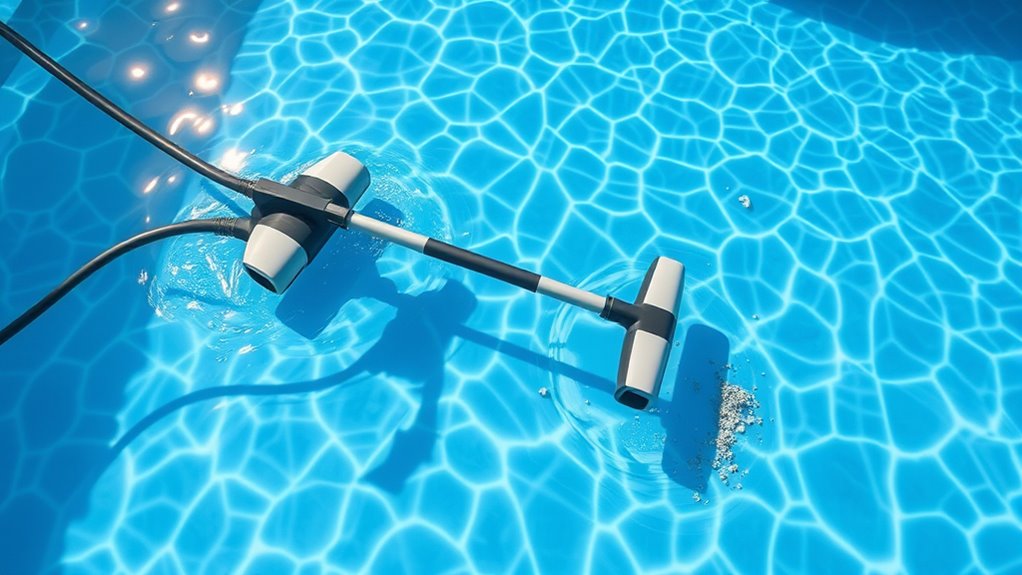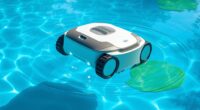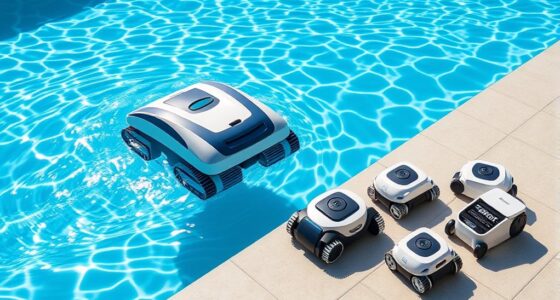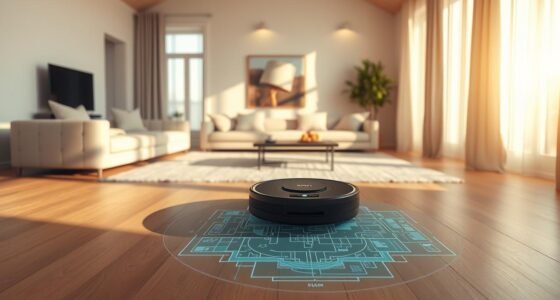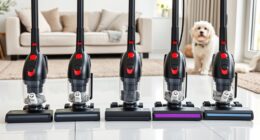To get the best results from your suction pool cleaner, avoid neglecting regular maintenance like cleaning filters and checking for wear. Make sure it’s positioned correctly to cover your pool fully and keep debris and obstructions out of its way. Use the right settings for your pool’s shape and size, and regularly monitor for mechanical issues. Staying on top of these points will keep your cleaner running smoothly—learn more to guarantee your pool stays pristine.
Key Takeaways
- Regularly clean and inspect filters, hoses, and seals to prevent debris buildup and mechanical wear.
- Properly position the cleaner with fully extended, tangle-free hoses and correct calibration for effective coverage.
- Remove obstacles like toys and debris before cleaning to avoid blockages and impaired movement.
- Monitor for unusual noises or movement issues to detect motor or component problems early.
- Schedule routine inspections and maintenance to catch wear early, ensuring longevity and optimal performance.
Neglecting Regular Maintenance and Filter Cleaning
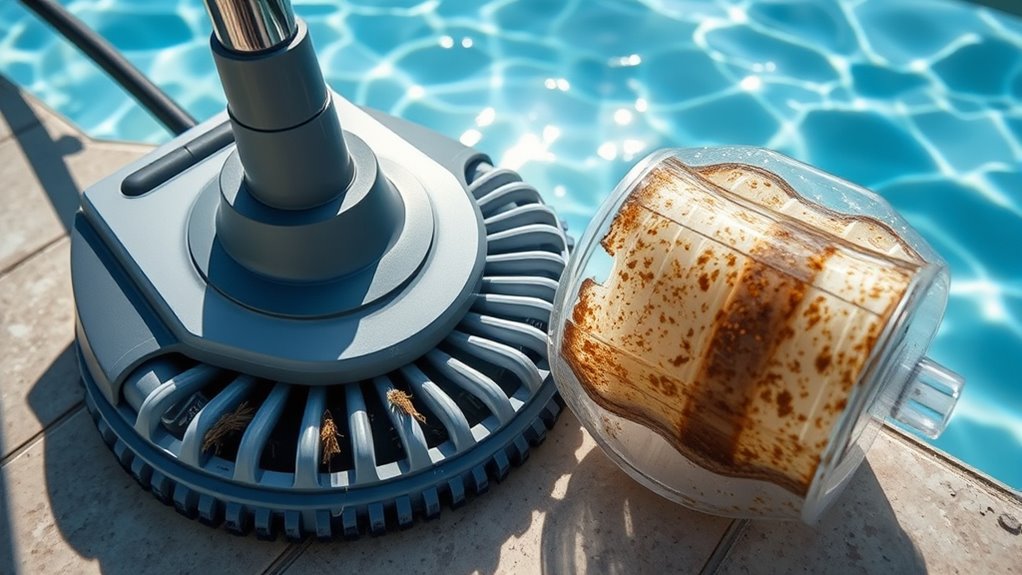
Neglecting regular maintenance and filter cleaning can substantially reduce your suction pool cleaner’s effectiveness. When filters aren’t cleaned regularly, debris builds up, restricting water flow and decreasing the cleaner’s suction power. Proper filter maintenance guarantees the cleaner can efficiently pick up dirt, leaves, and other debris. If you ignore debris removal from the filter, it can cause clogs and strain the motor, leading to potential damage or diminished lifespan. Make it a habit to check and clean your filter frequently, especially after heavy debris rainfall or heavy usage. Additionally, paying attention to filter efficiency can help identify when it needs replacement or repair to further optimize performance, especially considering the importance of pool equipment in overall pool health. Regularly inspecting and maintaining suction power ensures your cleaner operates at peak performance and prevents costly repairs. Keeping your filter clear not only maintains peak suction but also promotes better circulation and water quality. Incorporating preventative maintenance can further extend the lifespan of your pool equipment. A thorough understanding of pool system components can help you troubleshoot issues more effectively. Regular maintenance is a simple yet vital step to ensure your pool cleaner performs at its best.
Incorrectly Positioning the Cleaner for Optimal Coverage
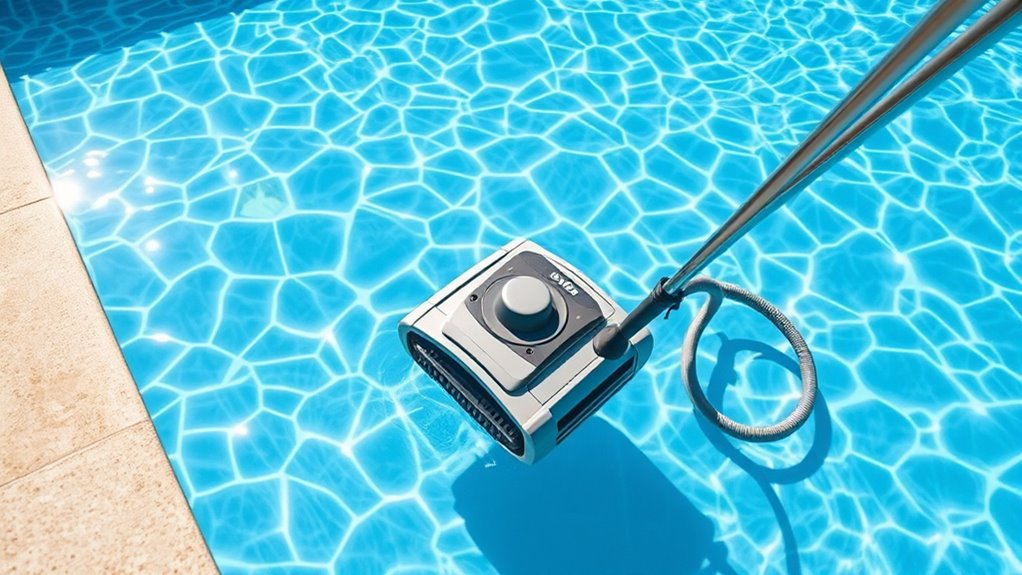
Properly positioning your suction pool cleaner is essential for achieving thorough coverage of your pool’s surfaces. Start with proper installation, ensuring the hose is fully extended and free of tangles. Correctly placing the cleaner in the pool allows it to reach all areas smoothly. Effective calibration of the cleaner’s wheels and float settings guarantees ideal movement patterns. Avoid placing the cleaner in a corner or near obstructions, as this limits coverage. Instead, position it centrally and ensure the suction intake isn’t blocked. Regularly check and adjust the cleaner’s position during operation for even cleaning. Additionally, maintaining the optimal contrast ratio of your pool’s lighting can help you better monitor the cleaner’s progress. Proper installation and calibration are crucial steps to prevent missed spots and ensure your pool stays clean with less effort. Also, making sure the suction power is adequate helps improve overall cleaning efficiency. By focusing on proper installation and effective calibration, you prevent missed spots and ensure your pool stays clean with less effort. Proper positioning is key to maximizing your cleaner’s efficiency and preventing performance issues. Furthermore, ensuring that the filter and pump system are functioning correctly supports optimal suction and cleaning performance.
Ignoring Pool Obstructions and Debris During Operation

If you ignore pool obstructions and debris during operation, your suction cleaner’s performance can suffer considerably. Leaves, toys, or a pool cover can block the cleaner’s path, reducing its efficiency and leaving dirt behind. Debris can also clog the filters, causing the cleaner to work harder and wear out faster. Additionally, neglecting to clear obstructions may lead to a chemical imbalance, as debris can trap contaminants that affect water chemistry. Always inspect the pool before starting and remove obstructions. Use the table below to identify common obstructions and their impact:
| Obstruction | Effect on Cleaner |
|---|---|
| Pool cover | Blocks suction, reduces cleaning coverage |
| Large debris | Clogs filters, impairs movement |
| Floating toys | Interferes with navigation |
Furthermore, incorporating regular maintenance can ensure optimal performance and longevity of your suction pool cleaner. Proper care and timely removal of debris help maintain the efficiency of your cleaning system, preventing unnecessary wear and potential damage. Regularly checking for electric dirt bike components such as filters and motors can also prevent unexpected breakdowns and extend the lifespan of your equipment. Paying attention to Glycolic Acid benefits for skin is not relevant here, but maintaining your pool’s filtration system is essential for overall water quality and equipment durability. Ensuring that your pool’s filtration system is well-maintained can also prevent issues related to water chemistry imbalance, which can otherwise compromise both water quality and equipment performance.
Using the Wrong Settings or Adjustments for Your Pool Type
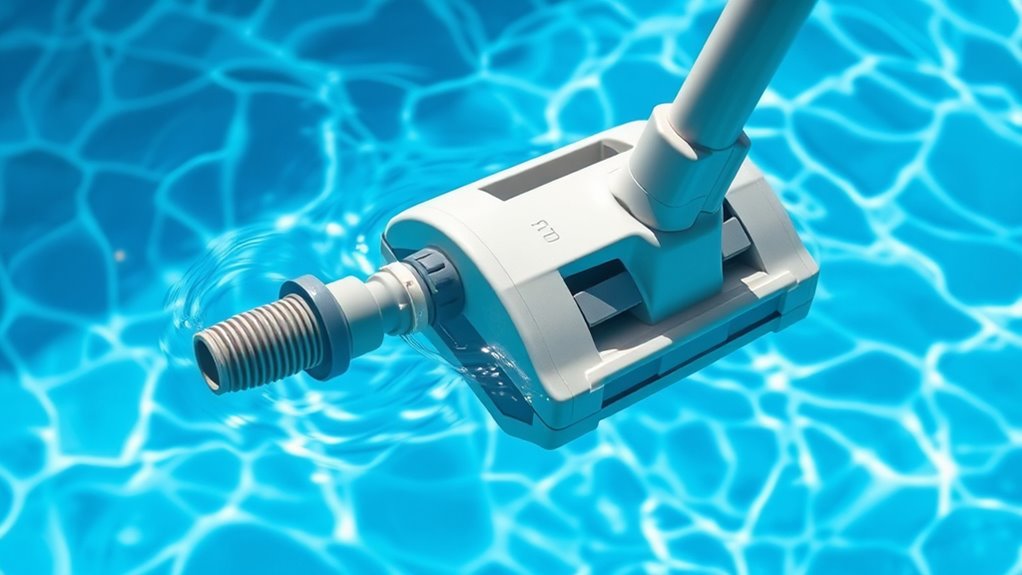
Using the wrong settings or adjustments for your pool type can markedly reduce your suction cleaner’s effectiveness. Many models offer automatic adjustment features to optimize cleaning based on pool size and shape, so make sure you enable this if available. If your cleaner isn’t compatible with your pool’s features, you may need to manually adjust settings like suction power or cleaning speed. Incorrect settings can lead to poor debris pickup, missed spots, or excessive wear on the device. Always consult your cleaner’s manual to ensure the settings match your pool’s specific design and surface. Properly matching your suction cleaner’s settings to your pool’s compatibility helps improve efficiency, prolongs the cleaner’s lifespan, and ensures a thorough, hassle-free cleaning session. Incorrect settings can also cause unnecessary strain on your device, leading to potential breakdowns. Additionally, understanding the types of pool surfaces can help you choose the most suitable adjustments for optimal cleaning results. Being aware of surface compatibility can prevent damage and ensure your cleaner operates smoothly on different materials. Taking into account specific surface requirements can further enhance cleaning performance and protect your equipment from damage. Moreover, selecting the right pool surface type ensures that your cleaner uses the appropriate settings for optimal maintenance and longevity.
Failing to Monitor and Address Wear and Mechanical Issues
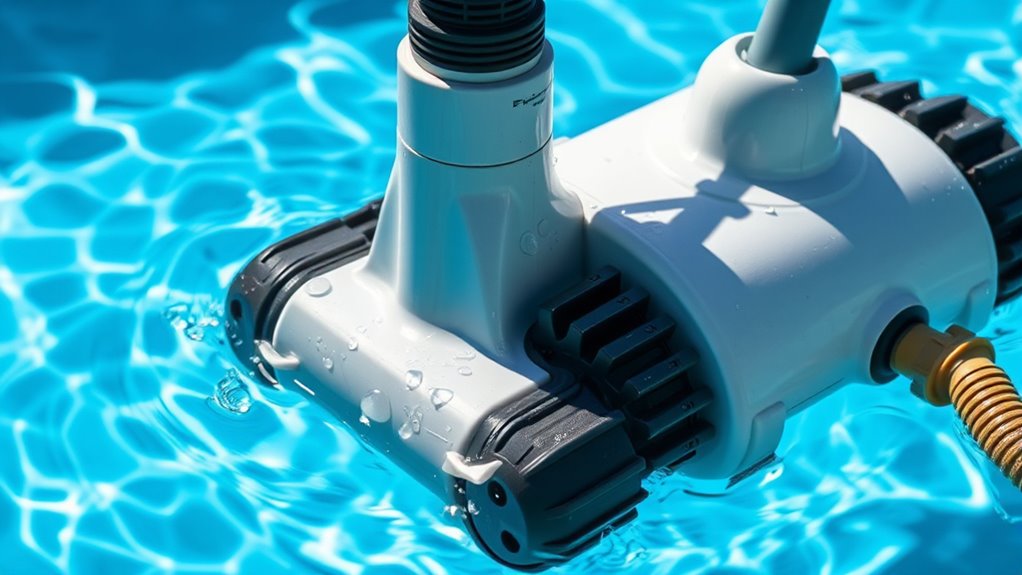
Neglecting to regularly inspect your suction pool cleaner for wear and mechanical issues can lead to decreased performance and costly repairs. Perform routine wear inspections on hoses, brushes, and seals to catch early signs of deterioration. Ignoring these signs can reduce cleaning efficiency and cause leaks. Additionally, don’t overlook motor troubleshooting; if your cleaner isn’t moving correctly or making unusual noises, the motor may need attention. Regularly check the motor’s operation, brushes, and connections to prevent breakdowns. Addressing wear and mechanical issues promptly ensures your cleaner functions at its best and extends its lifespan. Staying aware of wear patterns and behaviors can also help identify underlying issues early and prevent further damage. Developing a preventive maintenance routine can further minimize unexpected failures and save on repair costs. Incorporating scheduled inspections into your maintenance plan can help catch issues before they become severe, ensuring consistent operation. Being proactive about preventive measures allows you to identify potential problems early, reducing the likelihood of costly repairs. By staying vigilant with wear inspection and troubleshooting your motor as needed, you minimize downtime and avoid expensive repairs down the line.
Frequently Asked Questions
How Often Should I Replace Parts on My Suction Pool Cleaner?
You should replace parts on your suction pool cleaner based on its replacement schedule and signs of wear. Typically, check the hose, brushes, and seals every few months. If you notice damage or reduced performance, it’s time for part maintenance or replacement. Regular inspections help you catch issues early, ensuring your cleaner works efficiently and lasts longer. Staying on top of part maintenance keeps your pool cleaner in top shape.
Can I Use a Suction Pool Cleaner on All Pool Types?
Think of your suction pool cleaner as a Swiss Army knife—its versatility depends on pool compatibility. While many cleaners work well on concrete and vinyl pools, they might struggle with fiberglass or gunite surfaces. Always check your cleaner’s specifications to guarantee cleaner versatility across different pool types. Using the right cleaner for your pool guarantees efficient cleaning and prolongs your equipment’s lifespan.
What Safety Precautions Should I Take During Pool Cleaner Maintenance?
During pool cleaner maintenance, you should prioritize pool safety by turning off the pump and power supply before starting. Always handle electrical components carefully to avert electrical hazards, especially around water. Wear protective gloves and ensure the area is dry to prevent slips or shocks. Regularly inspect hoses and connections for damage, and keep children and pets away during maintenance to maintain a safe environment.
How Do I Troubleshoot if the Cleaner Gets Stuck Frequently?
If your pool cleaner gets stuck frequently, check for pool cleaner blockage or debris in the suction hose. Clear any obstructions and verify the hose isn’t kinked or twisted, which can cause suction hose issues. Make sure the cleaner’s wheels or tracks move freely and that the skimmer basket is clean. Regularly inspect the hose and brushes to prevent future blockages and keep the cleaner working efficiently.
Is It Necessary to Manually Remove Debris From the Cleaner’S Brushes?
You might think it’s tedious, but manual debris removal from your cleaner’s brushes is essential. Regular brush maintenance guarantees peak performance and prevents clogs. By removing debris, you keep the brushes clean and functioning smoothly, which helps your suction pool cleaner work more efficiently. Skipping this step can lead to reduced cleaning power and frequent stoppages. So, make it a routine to check and clear debris from the brushes for a sparkling pool.
Conclusion
To keep your pool sparkling and inviting, avoid these common mistakes. Regularly clean filters and check for debris, ensuring your cleaner glides smoothly across the water’s surface. Position it thoughtfully, like a skilled artist, so every inch of your pool is covered. Stay vigilant for obstructions and mechanical quirks, much like a seasoned captain steering calm waters. With attentive care, your suction pool cleaner becomes a silent guardian, transforming your pool into a pristine oasis.
